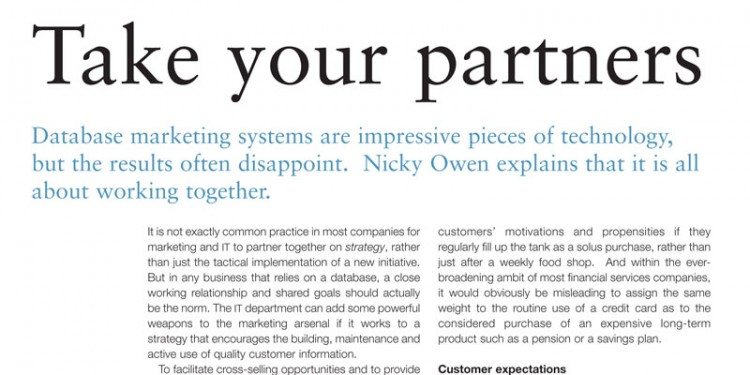Database marketing systems are impressive pieces of technology, but the results often disappoint. Nicky Owen explains that it is all about working together.
It is not exactly common practice in most companies for marketing and IT to partner together on strategy, rather than just the tactical implementation of a new initiative. But in any business that relies on a database, a close working relationship and shared goals should actually be the norm. The IT department can add some powerful weapons to the marketing arsenal if it works to a strategy that encourages the building, maintenance and active use of quality customer information. To facilitate cross-selling opportunities and to provide outstanding customer service, it is vital that this information is not only collected but is used to create one joined-up picture of the consumer – thus providing an accurate and relevant representation of the relationship an individual has with the brand. If this is done well, it can deliver service that leaves customers feeling friendly towards the business rather than frustrated.
Building the information bank and keeping it clean are both achieved in the same way. All the IT systems should use the same integrated model of customer information – and this should have a single view of a customer. This needn’t be the same physical data, but all information about a customer should fit together logically and not be duplicated. Every time and everywhere that customer information is created, changed or used, this single store of information should be changed in some way.
Therefore, every contact is used as an opportunity to collect useful and correct information that helps to create a full picture of each individual. That means that all IT systems that involve the customer – sales, product management, marketing, customer service – should, indeed must, be built on top of this logical model with the aim of using, enhancing and maintaining it. In this way, everyone has the latest information all the time. The increasing complexity of the retail relationships between suppliers and consumers means that the context of each interaction is also important. For example, it may say something significant about customers’ motivations and propensities if they regularly fill up the tank as a solus purchase, rather than just after a weekly food shop. And within the everbroadening ambit of most financial services companies, it would obviously be misleading to assign the same weight to the routine use of a credit card as to the considered purchase of an expensive long-term product such as a pension or a savings plan.
To read the full article, please download the PDF above.

